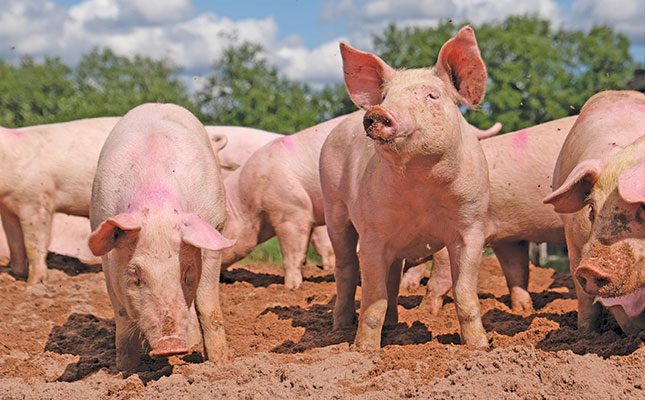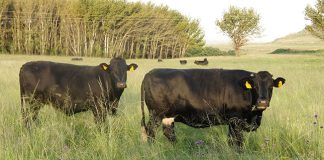
Photo: Wikimedia Commons
According to Prof Jannie Crafford, senior lecturer in the Department of Veterinary Tropical Diseases at the University of Pretoria, there are several key differences between African swine fever (ASF), classical swine fever (CSF) and swine flu. Some of these include the clinical signs, the way the disease affects pigs, and the risk of human infection.
“Knowing these differences can help to differentiate [one disease from another] and guide appropriate control measures. African swine fever, CSF (also known as hog cholera or European swine fever), and swine flu are three different diseases that can affect pigs, but their names are often used interchangeably, which can lead to oversights in how disease outbreaks are managed, and have serious ramifications for farmers and other stakeholders,” says Crafford.
African swine fever
According to the World Organisation for Animal Health (WOAH), ASF is responsible for “massive losses” in pig populations and “drastic economic consequences”.
The disease is endemic to Southern Africa, but currently affects several regions around the world, it adds. There is currently no effective vaccine. “ASF has detrimental impacts on biodiversity and the livelihoods of farmers, [due to its ease of spread and high mortality rate],” says the WOAH.
ASF is a viral disease. According to Crafford, the virus, like those that cause CSF and swine flu, is highly contagious and can spread rapidly between individual pigs and pig farms.
ASF can be transmitted in various ways, including through direct transmission (contact between sick and healthy animals), indirect transmission (feeding on garbage containing infected meat, fomites, and biological vectors like soft ticks) and within the tick vector (transstadial, transovarial, and sexual transmission occur).
“African swine fever is characterised as a haemorrhagic fever in domestic pigs that can kill up to 100% of infected animals. Pigs may develop a range of syndromes varying from peracute (severe, of a short duration, and generally rapidly fatal) to chronic and subclinical diseases.
“Clinical signs that may occur with virulent strains include fever, loss of appetite, and haemorrhaging under the skin and in the internal organs. In some cases, pigs may even die without having developed clinical signs.
“Less virulent strains may cause mild clinical signs such as fever, depression, and reduced appetite, which can easily be confused with many other conditions in pigs,” says Crafford.
The WOAH further explains that the incubation period in nature is usually four to 19 days. For the acute form of ASF, however, the incubation period is three to four days.
According to the organisation, the peracute form of ASF generally presents with few symptoms and, as described by Crafford, is rapidly fatal. This form is also highly virulent.
The acute form of ASF, which is also highly virulent and has a mortality rate of almost 100%, may present with the following symptoms, along with those described earlier by Crafford: reddening of the skin of white pigs, including the tips of ears, tail, distal extremities, and ventral aspects of chest and abdomen; increased pulse and respiratory rate; vomiting and diarrhoea; and discharge from the eyes.
The WOAH says death can occur within six to 13 days. In gestating sows, abortions may occur. The subacute form is moderately virulent and may present with the signs already described. The illness can last up to 30 days, and death can occur within 15 to 45 days.
The mortality rate of this form of ASF is between 30% and 70%, but varies widely, says the WOAH. Finally, the chronic form of ASF has moderate or low virulence, and can present with loss of weight, fluctuating temperatures, chronic skin ulcers and arthritis. Joints may also be swollen.
This type develops over two to 15 months and has a low mortality rate. “A small number of survivors may become carriers of the virus for life,” says the WOAH. It suggests the rapid slaughtering of all infected pigs to prevent the further spread of the disease.
Thorough cleaning and disinfection are also required. In addition, farmers are advised to avoid contact between pigs and wild boars, and to limit the wandering of pigs. It is also recommended that they avoid feeding their pigs untreated swill or kitchen scraps that contain meat.
Biosecurity measures are essential to limit and prevent the spread of ASF.
Classical swine fever
“Classical swine fever is caused by a pestivirus, which is closely related to viruses that cause bovine viral diarrhoea in cattle,” says Crafford. “Pigs with classical swine fever can present very similar clinical signs to [those with] African swine fever, and laboratory confirmation is important to differentiate between the two diseases.”
The WOAH describes CSF as a contagious viral disease of domestic and wild swine. It is commonly spread via direct contact between infected and healthy pigs. Pigs can also become infected indirectly by eating CSF-infected pork meat or products.
As with ASF, thorough disinfection and cleaning is required to contain and prevent the spread of the disease. “Applying strict and rigorous sanitary prophylaxis, and hygiene measures protecting domestic pigs from contact with wild boar are the most effective ways to prevent the disease,” says the WOAH.
“When an outbreak occurs, slaughter all pigs on affected farms and safely dispose of carcasses [and bedding]. Surveillance of the infected zone and surrounding areas [should be] applied. In areas where the disease is endemic, vaccination can prevent the spread of the disease. In disease-free areas, a stamping-out policy is applied and consists of early detection, movement control, proper disposal of carcasses, as well as cleaning and disinfection.”
There are two forms of CSF, acute and chronic, and the WOAH says these can range from severe to mild and even unapparent. The acute form has the highest mortality rate and presents with fever, the huddling together of sick animals, loss of appetite, dull appearance, weakness, conjunctivitis, constipation followed by diarrhoea, and an unsteady gait, says the WOAH.
“Several days after the onset of clinical signs, the ears, abdomen and inner thighs may show a purple discolouration.
“Animals with acute [CSF] die within one to two weeks. Severe cases of the disease appear very similar to African swine fever.”
With the chronic form of CSF, “the only expression may be poor reproductive performance and the birth of piglets with neurological defects, such as congenital tremor”.
Swine flu
Swine flu is an upper respiratory disease that is “characterised by fever, coughing, sneezing, nasal discharge, and laboured breathing. Animals usually recover quickly, and the mortality rate is low”, says Crafford, He adds that one of the key differences between ASF, CSF and swine flu is that ASF can be transmitted via soft ticks of the Ornithodorus genus, which occur in warthogs.
“African wild pigs like warthogs, bushpigs and giant forest hogs do not develop any signs of disease when infected with the African swine fever virus, and together with the ticks can act as reservoir hosts to maintain the virus in a sylvatic pathogen transmission cycle (one that involves a non-human animal host and insects). All wild hogs are susceptible to classical swine fever.”
He says that ASF and CSF can survive for long periods of time in processed pork products. “[In these diseases], pigs can become infected when eating swill that contains these products. Swine influenza viruses are not very hardy and cannot survive for long outside of the host.”
Moreover, adds Crafford, ASF and CSF do not cause disease in humans. “However, swine influenza viruses can occasionally infect and cause flu-like diseases in humans, especially those who handle infected animals,” he explains.
Swine flu is highly contagious and can spread very quickly within pig units, says the WOAH. Nonetheless, the mortality rate is low, and rapid recovery of infected animals can be expected. “[Despite this], morbidity rates can reach 100% with swine influenza infections.
The primary economic impact is related to retarded weight gain resulting in an increase in the number of days to reach market weight.” Transmission occurs through contact with secretions from an infected animal.
The WOAH explains that symptoms in pigs may develop within one to three days, with recovery expected within three to seven days if no secondary infections or complications are present.
Swine flu presents with fever, lethargy, anorexia, weight loss, and laboured breathing. Coughing, sneezing, and nasal discharge are also commonly seen, and gestating sows may also experience abortions.
“Pigs are known to be susceptible to avian, human, and swine influenza viruses, which can lead to the development of new variant viruses capable of causing pandemics in humans, as was the case in 2009 when a human variant of the H1N1 virus emerged – this is the virus that is commonly referred to as swine flu in humans,” says Crafford.
For this reason, the careful monitoring of pig diseases is essential, not only for the pork industry, but also for human health.
“Both African and classical swine fever are high-impact diseases that should be reported to the [WOHA]. They are also controlled by the national Department of Agriculture, Land Reform and Rural Development. Only African swine fever is currently present in pigs in South Africa,” concludes Crafford.
Sources: Swine Influenza (Influenza in Swine); Pig diseases: Know the differences between African swine fever, classical swine fever and swine flu to avoid incorrect interpretation and confusion; Classical swine fever











